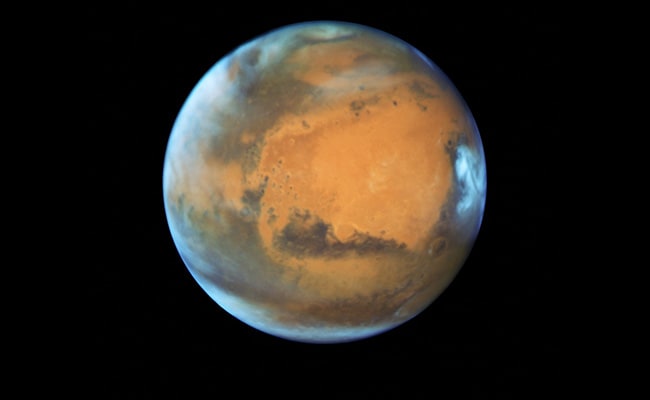Copied content from above link in case link expires.
Feb 28, 2022
Indian Mars Orbiter Mission (MOM) used for Investigating the Solar Corona by ISRO Scientists
Utilizing the solar conjunction event, when the Earth and Mars are on the opposite sides of the Sun, a team of scientists from Space Physics Laboratory of Vikram Sarabhai Space Centre, Trivandrum; Physical Research Laboratory, Ahmedabad; and ISRO Telemetry Tracking and Command Network (ISTRAC), Bangalore; used S-band radio signals coming from the Indian Mars Orbiter Mission (MOM) to study the Solar Corona. During conjunction events, which usually happens once in approximately two years for Mars, the radio signals from MOM passes through the solar corona, as close as 10 solar radii (1 solar radii (Rʘ) = 696,340 km = about 100 Earth radii), from the center of the Sun, thus providing a unique opportunity to study solar dynamics. ISRO scientists used the conjunction event of May-June 2015 – a time when the Sun's activity was quite low, to study the turbulence in the solar corona and found that transition of solar wind from sub-alfvenic to super-alfvenic flow occurs around 10–15 Rʘ during low solar activity period.
The outer atmosphere of the Sun, called the solar corona, is the region where the temperature is several million degrees Kelvin, rendering it quite inaccessible for
in-situ measurements thereby challenging the experimenters. The reason for such a high temperature of the corona is still an enigma. The solar wind, which originates in the corona and accelerates in this region, passes through the interplanetary spaces, shapes the magnetosphere of planets, as well as affects the near-Earth space environment through a phenomenon known as "Space Weather".
Since the solar corona is an ionized medium (plasma) and has its intrinsic turbulence, it is a dispersive medium for an electromagnetic radio wave passing through it. The radio signals from MOM spacecraft crossing through the solar corona during the conjunction event (cf. Figure 1) consequently experience dispersive effects. The turbulence in the corona produces fluctuations in plasma density which get registered as fluctuations in the phase of radio waves passing through it. Thus, the radio signals received at the ground station (Indian Deep Space Network, ISTRAC for MOM) contain the signature of propagating medium (solar corona) and can be spectrally analyzed to derive the turbulence spectrum of the medium. This forms the basis of the coronal radio-sounding technique which has been used by spacecraft to study coronal regions spanning maximum and minimum phases of different solar cycles.
ISRO scientists obtained coronal turbulence spectrum at heliocentric distances between 4 and 20 Rʘ by spectrally analyzing the Doppler frequency residuals from radio signals received from MOM spacecraft. This is the region where the solar wind primarily gets accelerated to velocities of a few hundreds of kilometers per second. The changes in turbulence regime are well reflected in spectral index values of the temporal frequency fluctuation spectrum. The scientists found that the turbulence power spectrum at a lower heliocentric distance (<10 Rʘ) has flattened at shorter frequencies with a smaller spectral index, which corresponds to the solar wind acceleration region. Smaller spectral index values closer to the Sun’s surface signify the energy input regime where turbulence is still underdeveloped. For larger heliocentric distances (> 10 Rʘ), the curve steepens with a spectral index close to 2/3, which is indicative of the inertial regime of a developed Kolmogorov-type turbulence, where energy is transported through cascading. This finding is consistent with those of theoretical models of solar wind turbulence and substantiates the process of turbulence energy transport and dissipation of magnetohydrodynamic waves, leading to coronal heating and solar wind acceleration in the near-Sun region.
Incidentally, this finding of ISRO scientists is also supported by the first direct observation of solar corona by Parker Probe, published very recently in an independent study.
Another intriguing observation is when the results of studies by MOM are compared with similar experiments conducted by the earlier missions which spanned past solar cycles. The work based on MOM data reports an insight into the feeble maxima of solar cycle 24, which is recorded as a peculiar solar cycle in terms of overall lower activity than any other previous solar cycle.
These outstanding science results on the solar coronal dynamics using MOM in an innovative way is published in the refereed journal
Monthly Notices of the Royal Astronomical Society, titled "A study on the solar coronal dynamics during the post-maxima phase of the solar cycle 24 using S-band radio signals from the Indian Mars Orbiter Mission", authored by Richa N. Jain,R. K. Choudhary, Anil Bhardwaj, Umang Parikh, Bijoy K. Dai, and Roopa M. V.
Monthly Notices of the Royal Astronomical Society,
DOI:
10.1093/mnras/stac056
https://academic.oup.com/mnras/advance-article-abstract/doi/10.1093/mnras/stac056/6506470
PS: - India’s first mission to Mars, the MOM, was launched on 5 November 2013, and arrived at Mars on 24 September 2014. The MOM was planned for a mission lifetime of 6 months, but has successfully surpassed it by a factor of 10
– now in Martian orbit for more than 7 years, and is doing well in the extended mission phase. The MOM has provided the first measurements of the evening time exosphere of Mars (1) and has discovered hot Argon in its upper atmosphere-exosphere by the MENCA experiment onboard MOM (2).
(1)
MENCA observed the evening exosphere of Mars
(2)
Observation of Suprathermal Argon in Mars Exosphere

Figure 1. Schematic of positions of Earth and MOM spacecraft relative to the Ecliptic plane of Sun (XY plane) as seen from Earth. Radio signals sent by spacecraft (dashed line) pass closer to the solar coronal region during this period.
 www.isro.gov.in
www.isro.gov.in
 www.isro.gov.in
www.isro.gov.in



